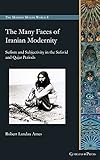The Many Faces of Iranian Modernity : Sufism and Subjectivity in the Safavid and Qajar Periods / Robert Ames.
Material type: TextSeries: The Modern Muslim World ; 8Publisher: Piscataway, NJ : Gorgias Press, [2021]Copyright date: ©2021Description: 1 online resource (213 p.)Content type:
TextSeries: The Modern Muslim World ; 8Publisher: Piscataway, NJ : Gorgias Press, [2021]Copyright date: ©2021Description: 1 online resource (213 p.)Content type: - 9781463242374
- 9781463242381
- 297.4 23
- BP188.8.I7 A46 2021
- online - DeGruyter
| Item type | Current library | Call number | URL | Status | Notes | Barcode | |
|---|---|---|---|---|---|---|---|
 eBook
eBook
|
Biblioteca "Angelicum" Pont. Univ. S.Tommaso d'Aquino Nuvola online | online - DeGruyter (Browse shelf(Opens below)) | Online access | Not for loan (Accesso limitato) | Accesso per gli utenti autorizzati / Access for authorized users | (dgr)9781463242381 |
Browsing Biblioteca "Angelicum" Pont. Univ. S.Tommaso d'Aquino shelves, Shelving location: Nuvola online Close shelf browser (Hides shelf browser)
Frontmatter -- TABLE OF CONTENTS -- ACKNOWLEDGMENTS -- INTRODUCTION -- CHAPTER ONE. LISTEN TO THE NAY: POETRY, SUFISM, AND THE KNOWING SUBJECT -- Chapter Two. Kāshifī’s Late Timurid Ethics and Mu’azzin Khurāsānī’s Shīʿī “Golden Chain” -- Chapter Three. Sufism Beyond Itself: Two Nineteenth-Century Responses to Rumi’s Masnavī -- Chapter Four. Humanity as Modern Religion: Ādamīyat, Insānīyat, and Qānūn in Mīrzā Malkum Khān and Safī ʿAlī Shāh -- Epilogue. Successions: Ethics, Knowledge, and the Constitutional Revolution -- Bibliography -- Index
restricted access online access with authorization star
http://purl.org/coar/access_right/c_16ec
This book proceeds from two related insights: the first of these is that Sufism in early modern Iran possessed a coherent theory of knowledge that reflected the period’s culture more broadly. The second is that this episteme not only survived modernization, but actually proliferated and took on new literary forms throughout the Qajar period (1785-1925). Sufism achieved this influence in the modern era despite the fact that the nineteenth and twentieth centuries are usually figured as ruptures with the early modern intellectual life of the Timurid (1370-1501) and Safavid periods (1501-1722), when its role in intellectual life was more visible, if also controversial. This study into both reformism and mysticism demonstrates both that mystical rhetoric appeared regularly in supposedly anti-mystical modernist writing and that nineteenth- and twentieth-century Sufis actually addressed questions of intellectual and political reform in their writing, despite the common assertion that they were irrationally traditional and politically quietist.
Mode of access: Internet via World Wide Web.
In English.
Description based on online resource; title from PDF title page (publisher's Web site, viewed 01. Dez 2022)









